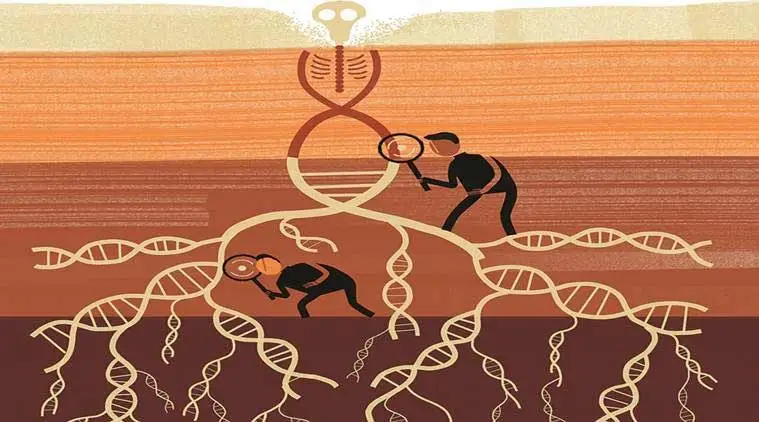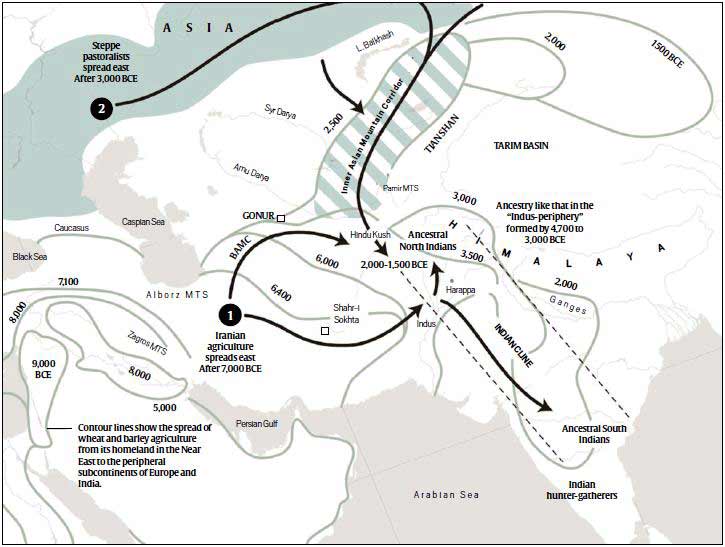The Long Walk: Did the Aryans migrate into India? New genetics study adds to debate
Co-authored by 92 leading scientists, it offers new insights into makeup of the Indian population. Will it settle or again trigger the contentious debate?

The study which is yet to be peer-reviewed does not use the term ‘Aryan’. It says Steppe pastoralists around the Volga and Don rivers in Russia moved towards India encountering the Indus Valley population. (Illustration: C R Sasikumar)
The study
Titled ‘The Genomic Formation of South and Central Asia’, the study looks at “ancient DNA” from 357 individuals from Central and South Asia to say that there was indeed some kind of migration into India around the 2nd millennium BCE, towards the end of the Indus Valley Civilisation. Overall, the dataset included 612 ancient individuals that were then co-analysed with genome-wide data from present-day individuals. The study which is yet to be peer-reviewed does not use the term ‘Aryan’. It says Steppe pastoralists around the Volga and Don rivers in Russia moved towards India encountering the Indus Valley population. “[T]hey mixed with a more southern population that we document at multiple sites as outlier individuals exhibiting a distinctive mixture of ancestry related to Iranian agriculturalists and South Asian hunter-gatherers,” the study states.
Mixing of population groups
The study is based on the understanding that present-day South Asians have descended from a mixture of two highly divergent populations: Ancestral North Indians (ANI) and Ancestral South Indians (ASI). The research reveals a complex set of genetic sources that combine three potential groupings that mixed together in various ways to create the ANI and ASI. The first are the South Asian hunter-gatherers, who are described in the study as AASI or Ancient Ancestral South Indians. These were the Onge or the indigenous population of the Andaman Islands. Second, is the Iranian agriculturalists, represented by 8th millennium BCE pastoralists from the Zagros mountains, who were known to have come to the subcontinent.
Then, there are the Steppe pastoralists, often loosely referred to as the ‘Aryans’, who inhabited the vast Central Asia grasslands. The study reveals that in the beginning, the Indus Valley population was a result of the mixing of first and second groups. Then the Steppe pastoralists moved Southwards and mixed with the Indus Valley population. Further, people from Indus Valley moved southwards to merge with the South Asian hunter-gatherers to form the ASI. In the meantime, a genome admixture took place in the north between the population from the Steppe and the Indus Valley to create the ANI population stock. Later, the ANI and ASI continued to mix with each other to create almost the entire ancestry of South Asian population. The study works with the Indus Valley Periphery data and uses data of individuals from Central Asian sites that they believe to be related to the Indus Valley people, even as genetic data from the Harappan sites are yet to be released.
Another finding is the connection between the Steppe pastoralists and the priestly castes, and cultures of North India. The research finds that 10 out of 140 Indian groups studied have a higher amount of Steppe ancestry than Indus Valley ancestry, the highest two were ‘Brahmin-Tiwari’ and ‘Brahmin-UP’. The study points out that “although the enrichment for Steppe ancestry is not found in southern Indian groups, the Steppe enrichment in the northern groups is striking as Brahmins and Bhumihars are among the traditional custodians of texts written in early Sanskrit”.
Significance
According to author and former Businessworld editor Tony Joseph, who has written extensively on early Indians, the study is “pathbreaking” because DNA from 612 ancient individuals were co-analysed with DNA from present-day individuals and “this is what makes this study dramatically different from previous studies”. “In the last five years, the techniques for extracting and analysing ancient DNA has improved by leaps and bounds, and this is helping us understand our prehistory far better, not just in South Asia, but around the world. For example, in the last five years, we have learnt that Europe went through two major mass migrations that changed their demography, and in the same period, we have also learnt that the Americas, before European arrivals, were peopled by at least four migrations from Asia. So the findings about South Asia are just one part of the revolution that ancient DNA is bringing to prehistory across the world.”
Essentially, Joseph points out, the study shows that there are no “pure” people anywhere — except perhaps in some very isolated and remote places such as some of the Andaman and Nicobar islands. “We are all mixed. Almost all parts of the world have seen repeated mass migrations that have deeply impacted their demography and India is no exception. The genetic studies should be liberating in a way because it should make us aware that we are all interconnected.”
David Reich, a geneticist at Harvard Medical School and one of the authors of the study, too, points this out in his new book, Who We Are and How We Got Here. Writing in the context of a previous study that he worked on, in which he classified present-day Indians as the outcome of mixtures between ANI and ASI, he said, “The ANI are related to Europeans, central Asians, Near Easterners, and people of the Caucasus, but we made no claim about the location of their homeland or any migrations. The ASI descend from a population not related to any present-day populations outside India. We showed that the ANI and ASI had mixed dramatically in India. The result is that everyone in mainland India today is a mix, albeit in different proportions, of ancestry related to West Eurasians, and… more closely related to diverse East Asian and South Asian populations. No group in India can claim genetic purity.”
Criticism
However, the study has invited criticism from some. ICHR member and guest professor at IIT Gandhinagar, Michel Danino, said that the study is “steeped in circularity”. “It accepts the Indo-European migrations into Europe and into South Asia as a fact, then repeatedly fits the genetic evidence to this ‘fact’. This is faulty methodology…,” he said. He pointed out that “No ancient Harappan DNA has been analysed, which could have provided some secure comparison for contemporary samples in Central Asia and elsewhere.”
Danino also says that the study assumes that South Asia was more or less empty of population in the pre-Harappan era. “It sweeps aside the subcontinent’s Mesolithic and Neolithic populations which undoubtedly have substantial contributions to the South Asian genome. It considers such Mesolithic and Neolithic populations only in the context of Central Asia and Europe! This is one example [among others] of a strong Eurocentric bias in the study,” he says.
For all the latest Explained News, download Indian Express App






















 The map shows the plausible expansion of Near Eastern agriculture, human movements, and mixture, thereby spreading languages across the subcontinent.
The map shows the plausible expansion of Near Eastern agriculture, human movements, and mixture, thereby spreading languages across the subcontinent.
No hay comentarios:
Publicar un comentario